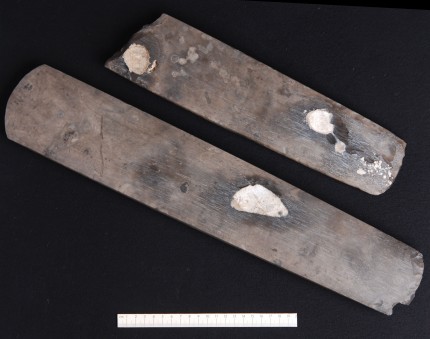 Tage Pinnerup was digging a new drain on his old friend Henrik Hansen’s property near the village of Kobberup on Denmark’s Jutland peninsula when he saw something sticking up out of the ground. It was a long, smooth almost rectangular piece of flint 50.5 centimeters (20 inches) long. Pinnerup had found a prehistoric axe before, so he recognized it as such, but because of how exceptionally large and finely worked it was, he figured it had to date to the Iron Age. A few days later he and Henrik Hansen found another one, this one 35 centimeters (14 inches) long.
Tage Pinnerup was digging a new drain on his old friend Henrik Hansen’s property near the village of Kobberup on Denmark’s Jutland peninsula when he saw something sticking up out of the ground. It was a long, smooth almost rectangular piece of flint 50.5 centimeters (20 inches) long. Pinnerup had found a prehistoric axe before, so he recognized it as such, but because of how exceptionally large and finely worked it was, he figured it had to date to the Iron Age. A few days later he and Henrik Hansen found another one, this one 35 centimeters (14 inches) long.
They alerted the authorities to a potential treasure find, and Viborg Museum experts determined that they were not Iron Age, but rather Neolithic flint axes dating to 3800-3500 B.C. Back then the find site was a marshy area next to Tastum Lake, long since drained and converted into arable land. Because they were found in a bog, are a matched pair and so carefully worked, the axes weren’t likely to have been misplaced. Archaeologists believe they were deliberately deposited in the bog as ritual offerings. The 50.5 cm axe is the largest Neolithic flint axe ever discovered in Denmark.
“It’s fascinating that they could master the flint and produce such a perfect axe,” said Mikkel Kieldsen, an archaeologist and curator at Viborg Museum. “A lot of effort has been put into the axes, so the sacrifice must have really meant something.”

Flint is a challenging material to work. Like glass, it breaks easily and requires very careful handling. Judging from modern experiments replicating prehistoric flint tools, Kieldsen estimates it would have taken the craftsmen who produced these axes hundreds of hours to achieve so polished a result. Compare the slender length and cricket bat-like smoothness to this axe from around the same time as the Tastum axes, or these, which are about a thousand years younger and bear the characteristic divots and sheers of knapped flint.
That long, slender polish suggests these were not practical tools. The flint axe was an essential tool to Neolithic farmers who used it to clear wooded land for agriculture. It had to be sturdy, thick through the middle and razor sharp at the end to do the job properly. A narrow, long, thin axe would likely crack at the first blow. It’s connection to the still-new trend of agriculture made the axe a powerful cultural symbol and well as a highly prized piece of property, which is why they have been found in the passage graves and dolmens which were built in grand style at the same time the Tastum axes were made.
Archaeologists excavated the site further to see if their were any other artifacts to be found and came up empty. The axes are treasure trove and will be sent to the National Museum of Denmark for assessment next month. Before that happens, they will be on display at the Viborg Museum for the next three weeks.